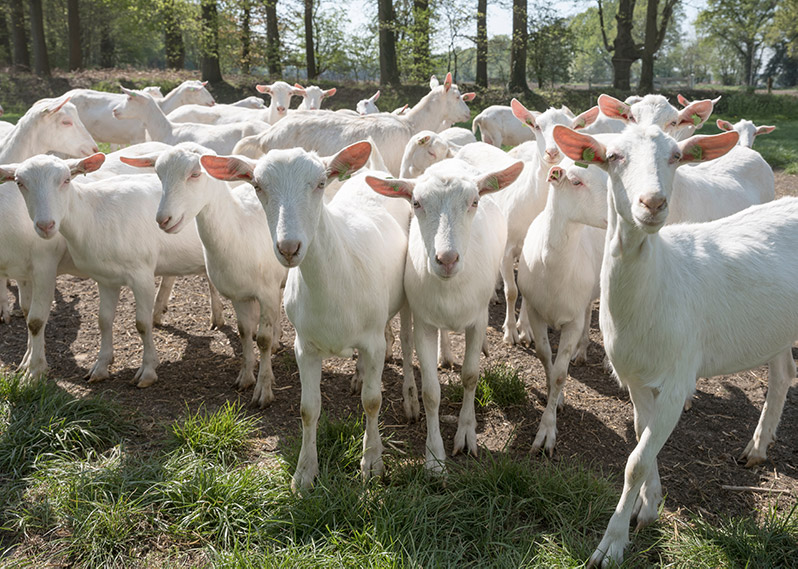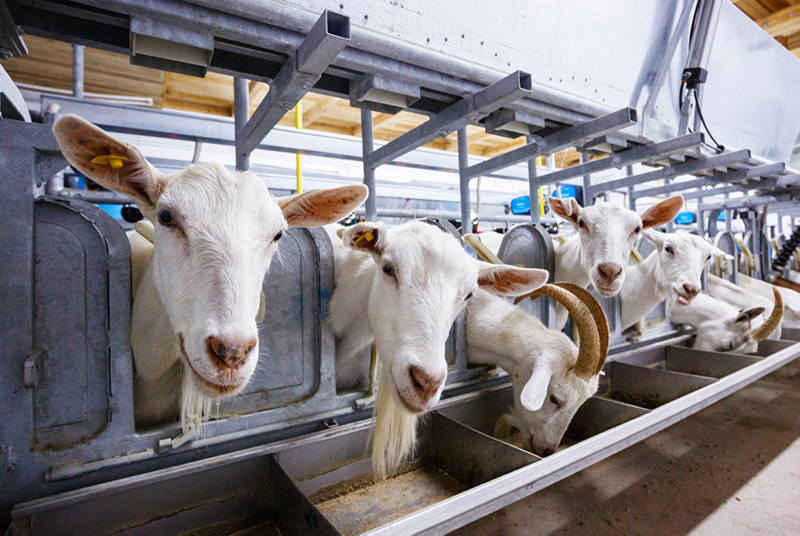Section 3 | Tackling Clinical Mastitis in Dairy Animals
Industry
Page 13 /
Treatment and Prevention of Clinical Mastitis
Treating with the right products at the right time is important to prevent some of the negative consequences of mastitis. One major challenge is the lack of approved antimicrobials for use in sheep and goats (see Challenges with Extra-Label Drug Use). This means it is important to work closely with your veterinarian to determine when antimicrobials need to be administered along with other supportive therapy.
Your veterinarian will also advise you of the appropriate meat and milk withdrawal times to prevent violative residues in food.

Some important things to consider:
- The majority of mastitis treatment options are extra-label
- Some of the bacteria that cause mastitis can also cause disease in humans consuming unpasteurized sheep or goat milk
It’s best to focus on prevention!
There are several keys areas where preventative strategies could be put into place:
Milking Management
Sheep and goats are not just small cows — their milking process is greatly different to account for their variations in metabolism and physiology. We need to keep this in mind when designing milking routines and adjusting parlor settings.
The milking routine is a critical component to achieving and maintaining excellent udder health. Some important things to consider in the milking routine include1:
Pre-milking teat preparation
- There has been very little research in sheep and goats evaluating the effectiveness of teat dips applied prior to milking (“predips”). Antimicrobial predips help reduce the number of bacteria on teats before milking units are attached.
- Stimulating teats to initiate milk let down
- Forestripping helps to identify abnormal-looking milk.. This could lead to earlier detection of clinical mastitis and faster interventions
- This is a recommended practice that improves sanitary status of milk collected
- Results in more efficient milk flow
- Forestripping helps to identify abnormal-looking milk.. This could lead to earlier detection of clinical mastitis and faster interventions
Milking order
- Many of the pathogens that cause mastitis can be transmitted at milking time. Milking animals with mastitis last can help to reduce the number of animals becoming infected. This is of particular importance with bacteria such as Staphylococcus aureus, a contagious pathogen
Post-milking teat disinfection
- The use of iodine based post-milking teat dip is an effective method of preventing new intramammary infections with bacteria2

It is also very important to get parlor settings adjusted to suit your herd or flock. Your milking equipment needs to be routinely inspected by an experienced service technician. Routine maintenance can quickly identify problems with your system, such as liner cracks, vacuum fluctuations, and accumulation of dirt and bacteria in the system. If not addressed, these problems could lead to poor milk quality and an increased incidence of mastitis.
Automatic cluster removal can help improve udder health. This technology reduces overmilking and leads to improved teat condition, better udder health, and labour savings.
Environmental Management
Pathogens that cause mastitis can live for long periods in the environment of sheep and goats. This combined with the fact that these types of dairy animals tend to live in close quarters can exacerbate and increase the spread of mastitis-causing pathogens. Good husbandry is extremely important. Pasture and other housing systems should be maintained to ensure they are clean and dry, and appropriate stocking densities should be observed at all times. This can be accomplished by keeping alleyways scraped and free of manure, ensuring stalls or packs are clean and well bedded, and preventing as much as possible the buildup of manure, mud, and pools of stagnant water.
Wherever there is manure, urine, and water, there are mastitis pathogens!
Dry Period Management
Non-lactating group housing needs to be clean, dry, and free of manure. Even animals that are not milking can pick up a mastitis infection — you might not even see mastitis clinically until she starts lactating again!
There are several studies that suggest that using intramammary antimicrobials at the end of lactation prevents infections and cures existing cases of subclinical mastitis. However, blanket antimicrobial therapy (e.g. every gland of every dry animal is treated with antimicrobial medications) should only be applied in herds/flocks that have mastitis problems. For other herds, using antimicrobials only for animals that have a mastitis infection (or a history of mastitis) may be preferable2. As use of these antimicrobial products is extra-label, work with your veterinarian to develop a dry period management protocol3.
Mastitis, whether clinical or subclinical, occurs commonly in sheep and goats. It is important to identify animals with mastitis early. Acting quickly gives you the best chances for a cure. Culturing mastitis milk lets you know what’s causing the issues on your farm. This helps guide you and your vet when creating tailored mastitis prevention strategies.
Working with your veterinarian on treatment and prevention programs can help to reduce the impact of mastitis!
References
- Dzidic, A., M. Rovai, J.L. Poulet, M. Leclerc, P.G. Marnet. 2019. Review: Milking routines and cluster detachment levels in small ruminants. Animal. 13.
- Contreras, A., D. Sierra, A. Sanchez, J.C. Corrales, J.C. Marco, M.J. Paape, and C. Gonzalo. 2007. Mastitis in small ruminants. Small Ruminant Research. 68:145-153.
- Olechnowicz, J., J.M. Jaskowski. 2014. Mastitis in small ruminants. Med. Weter. 70.